Abstract
Upon ethyl nitrosourea treatment of RNA of tobacco mosaic virus, up to four phosphodiester groups may be alkylated per molecule without chain breakage, as shown be sucrose gradient centrifugation. This indicates that ribophosphotriesters are quite stable. However, when this alkylation reaction is of longer duration and 6 to 10 triesters are formed, then an average of 1 to 2 breaks occurs and little or no intact RNA can be isolated. Methyl nitrosourea is less effective in forming triesters (about 25% of total alkyl groups compared to about 65% for ethyl nitrosourea), and a greater number of alkyl groups can, therefore, be introduced before breaks occur. Diethyl sulfate and dimethyl sulfate, which alkylate almost only the bases of nucleic acids, do not cause significant degradation of RNA of tobacco mosaic virus, even when as many as 70 alkyl groups are bound. All types of alkylation cause similar losses in viral infectivity at low levels of alkylation. Thus, an average of two chemical events leads to one lethal event, regardless of the nature of the alkylating reaction, which, for example, is with dimethyl sulfate about 65% on the N-7 guanine while with ethyl nitrosourea it is about 65% on phosphodiesters. It is thus concluded that all alkyl groups, whether on the base or on the phosphate, have the same potential to cause inactivation and that inactivation of RNA can result from phosphotriester formation per se.
Full text
PDF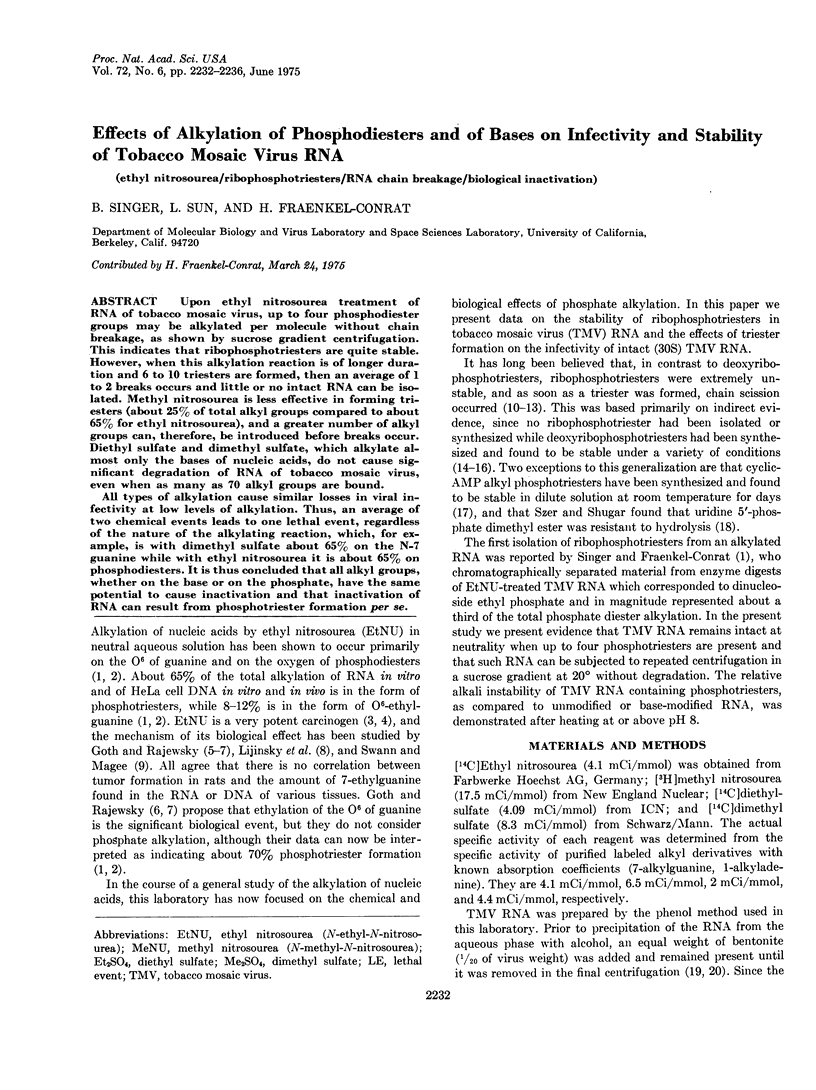
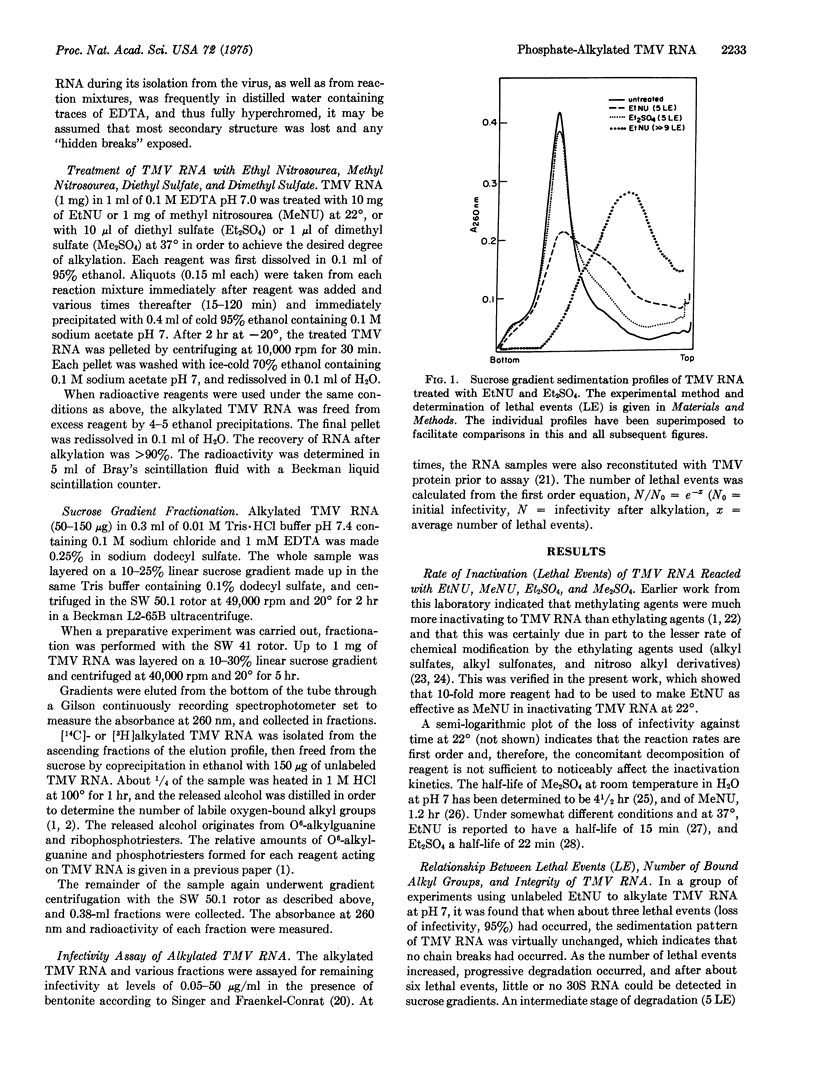
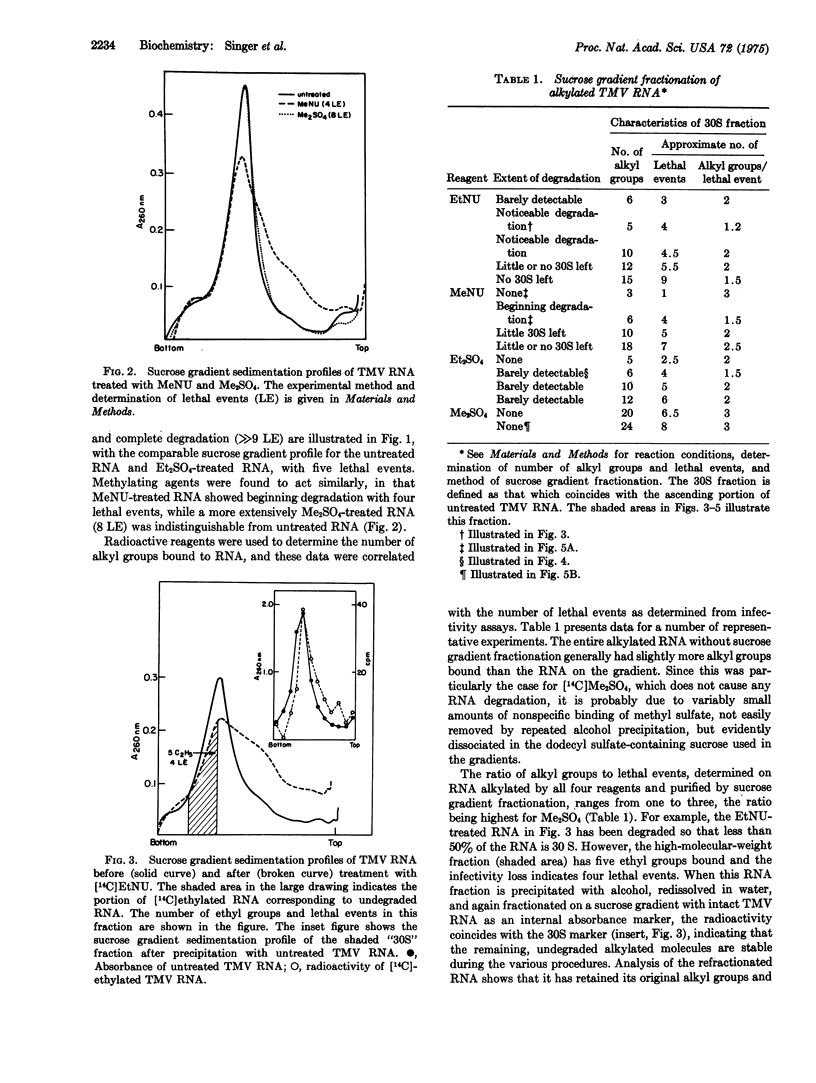
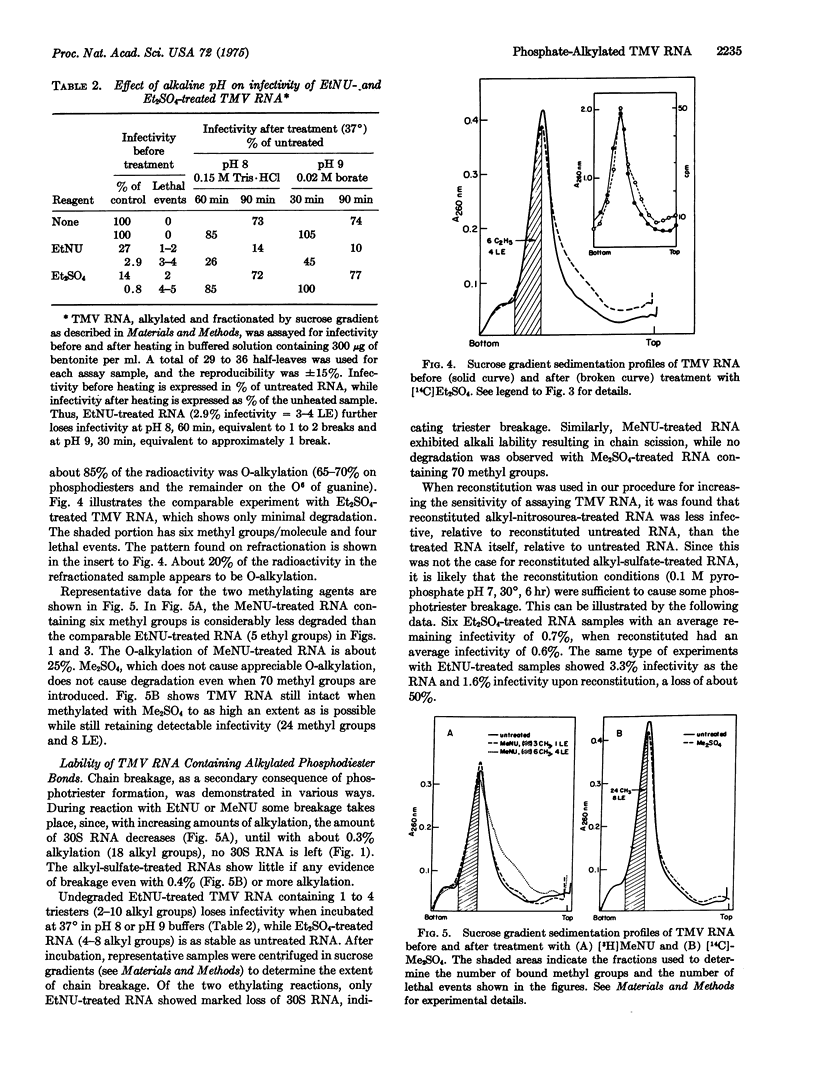
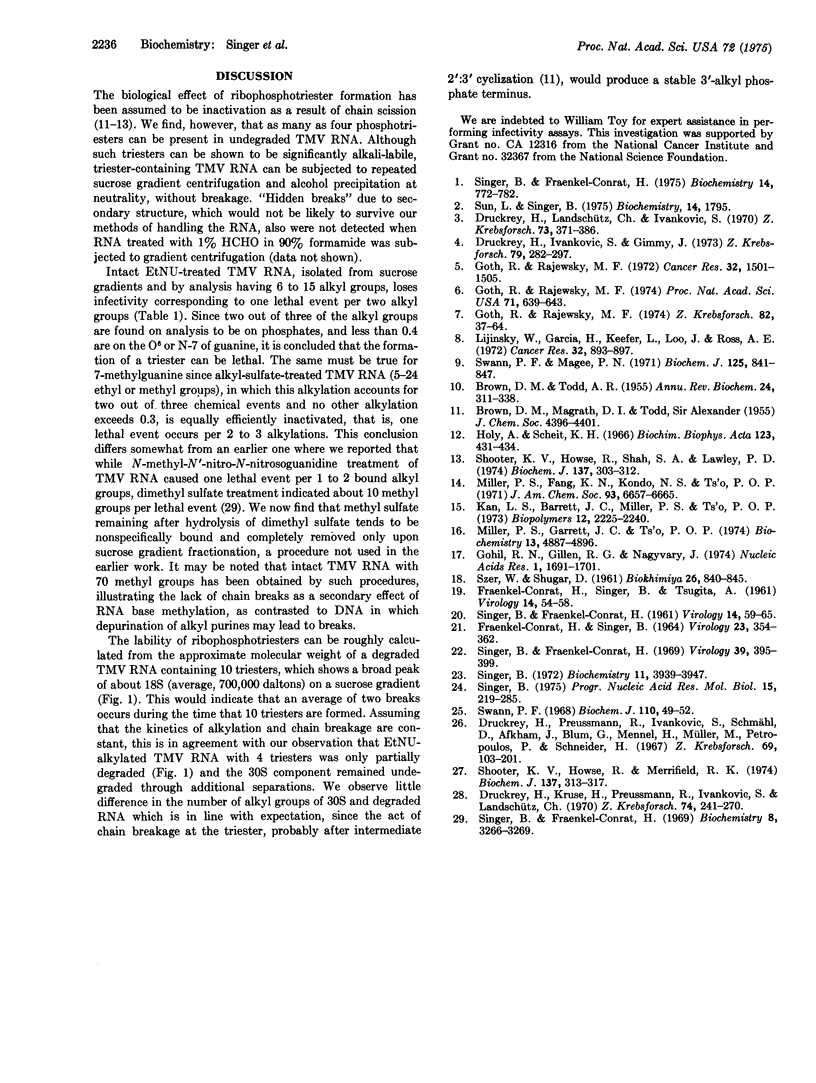
Selected References
These references are in PubMed. This may not be the complete list of references from this article.
- BROWN D. M., TODD A. R. Nucleic acids. Annu Rev Biochem. 1955;24:311–338. doi: 10.1146/annurev.bi.24.070155.001523. [DOI] [PubMed] [Google Scholar]
- Druckrey H., Ivankovic S., Gimmy J. Cancerogene Wirkung von Methyl- und Athylnitrsoharnstoff (MNH und ANH) nach einmaliger intracerebraler bzw. intracarotidaler Injektion bei neugeborenen und jungen BD-Ratten. Z Krebsforsch Klin Onkol Cancer Res Clin Oncol. 1973 Jun 19;79(4):282–297. doi: 10.1007/BF00304022. [DOI] [PubMed] [Google Scholar]
- Druckrey H., Kruse H., Preussmann R., Ivankovic S., Landschütz C. Cancerogene alkylierende Substanzen. 3. Alkyl-halogenide, -sulfate, -sulfonate und ringgespannte Heterocyclen. Z Krebsforsch. 1970;74(3):241–273. [PubMed] [Google Scholar]
- Druckrey H., Landschütz C., Ivankovic S. Transplacentare Erzeugung maligner Tumoren des Nervensystems. II. Athyl-nitrosoharnstoff an 10 genetisch definierten Rattenstämmen. Z Krebsforsch. 1970 Mar 10;73(4):371–386. [PubMed] [Google Scholar]
- Druckrey H., Preussmann R., Ivankovic S., Schmähl D. Organotrope carcinogene Wirkungen bei 65 verschiedenen N-Nitroso-Verbindungen an BD-Ratten. Z Krebsforsch. 1967;69(2):103–201. [PubMed] [Google Scholar]
- FRAENKEL-CONRAT H., SINGER B. RECONSTITUTION OF TOBACCO MOSAIC VIRUS. IV. INHIBITION BY ENZYMES AND OTHER PROTEINS, AND USE OF POLYNUCLEOTIDES. Virology. 1964 Jul;23:354–362. doi: 10.1016/0042-6822(64)90257-0. [DOI] [PubMed] [Google Scholar]
- FRAENKEL-CONRAT H., SINGER B., TSUGITA A. Purification of viral RNA by means of bentonite. Virology. 1961 May;14:54–58. doi: 10.1016/0042-6822(61)90131-3. [DOI] [PubMed] [Google Scholar]
- Gohil R. N., Gillen R. G., Nagyvary J. Synthesis and properties of some cyclic AMP alkyl phosphotriesters. Nucleic Acids Res. 1974 Dec;1(12):1691–1701. doi: 10.1093/nar/1.12.1691. [DOI] [PMC free article] [PubMed] [Google Scholar]
- Goth R., Rajewsky M. F. Ethylation of nucleic acids by ethylnitrosourea-1- 14 C in the fetal and adult rat. Cancer Res. 1972 Jul;32(7):1501–1505. [PubMed] [Google Scholar]
- Goth R., Rajewsky M. F. Molecular and cellular mechanisms associated with pulse-carcinogenesis in the rat nerbous system by ethyinitrosourea: ethylation of nucleic acids and elimination rates of ethylated bases from the DNA of different tissues. Z Krebsforsch Klin Onkol Cancer Res Clin Oncol. 1974;82(1):37–64. doi: 10.1007/BF00304382. [DOI] [PubMed] [Google Scholar]
- Goth R., Rajewsky M. F. Persistence of O6-ethylguanine in rat-brain DNA: correlation with nervous system-specific carcinogenesis by ethylnitrosourea. Proc Natl Acad Sci U S A. 1974 Mar;71(3):639–643. doi: 10.1073/pnas.71.3.639. [DOI] [PMC free article] [PubMed] [Google Scholar]
- Holy A., Scheit K. H. On the methylation of dinucleoside phosphates with diazomethane. Biochim Biophys Acta. 1966 Aug 17;123(2):430–431. doi: 10.1016/0005-2787(66)90298-x. [DOI] [PubMed] [Google Scholar]
- Kan L. S., Barrett J. C., Miller P. S., Ts'o P. O. Proton magnetic resonance studies of the conformational changes of dideoxynucleoside ethyl phosphotriesters. Biopolymers. 1973;12(10):2225–2240. doi: 10.1002/bip.1973.360121004. [DOI] [PubMed] [Google Scholar]
- Lijinsky W., Garcia H., Keefer L., Loo J., Ross A. E. Carcinogenesis and alkylation of rat liver nucleic acids by nitrosomethylurea and nitrosoethylurea administered by intraportal injection. Cancer Res. 1972 May;32(5):893–897. [PubMed] [Google Scholar]
- Miller P. S., Barrett J. C., Ts'o P. O. Synthesis of oligodeoxyribonucleotide ethyl phosphotriesters and their specific complex formation with transfer ribonucleic acid. Biochemistry. 1974 Nov 19;13(24):4887–4896. doi: 10.1021/bi00721a003. [DOI] [PubMed] [Google Scholar]
- Miller P. S., Fang K. N., Kondo N. S., Ts'o P. O. Syntheses and properties of adenine and thymine nucleoside alkyl phosphotriesters, the neutral analogs of dinucleoside monophosphates. J Am Chem Soc. 1971 Dec;93(24):6657–6665. doi: 10.1021/ja00753a054. [DOI] [PubMed] [Google Scholar]
- Shooter K. V., Howse R., Merrifield R. K. The reaction of alkylating agents with bacteriophage R17. Biological effects of phosphotriester formation. Biochem J. 1974 Feb;137(2):313–317. doi: 10.1042/bj1370313. [DOI] [PMC free article] [PubMed] [Google Scholar]
- Shooter K. V., Howse R., Shah S. A., Lawley P. D. The molecular basis for biological inactivation of nucleic acids. The action of methylating agents on the ribonucleic acid-containing bacteriophage R17. Biochem J. 1974 Feb;137(2):303–312. doi: 10.1042/bj1370303. [DOI] [PMC free article] [PubMed] [Google Scholar]
- Singer B., Fraenkel-Conrat H. Chemical modification of viral ribonucleic acid. 8. The chemical and biological effects of methylating agents and nitrosoguanidine on tobacco mosaic virus. Biochemistry. 1969 Aug;8(8):3266–3269. doi: 10.1021/bi00836a020. [DOI] [PubMed] [Google Scholar]
- Singer B., Fraenkel-Conrat H. Mutagenicity of alkyl and nitroso-alkyl compounds acting on tobacco mosaic virus and its RNA. Virology. 1969 Nov;39(3):395–399. doi: 10.1016/0042-6822(69)90087-7. [DOI] [PubMed] [Google Scholar]
- Singer B. Reaction of guanosine with ethylating agents. Biochemistry. 1972 Oct 10;11(21):3939–3947. doi: 10.1021/bi00771a017. [DOI] [PubMed] [Google Scholar]
- Singer B. The chemical effects of nucleic acid alkylation and their relation to mutagenesis and carcinogenesis. Prog Nucleic Acid Res Mol Biol. 1975;15(0):219–284. [PubMed] [Google Scholar]
- Sun L., Singer B. The specificity of different classes of ethylating agents toward various sites of HeLa cell DNA in vitro and in vivo. Biochemistry. 1975 Apr 22;14(8):1795–1802. doi: 10.1021/bi00679a036. [DOI] [PubMed] [Google Scholar]
- Swann P. F., Magee P. N. Nitrosamine-induced carcinogenesis. The alkylation of N-7 of guanine of nucleic acids of the rat by diethylnitrosamine, N-ethyl-N-nitrosourea and ethyl methanesulphonate. Biochem J. 1971 Dec;125(3):841–847. doi: 10.1042/bj1250841. [DOI] [PMC free article] [PubMed] [Google Scholar]
- Swann P. F. The rate of breakdown of methyl methanesulphonate, dimethyl sulphate and N-methyl-N-nitrosourea in the rat. Biochem J. 1968 Nov;110(1):49–52. doi: 10.1042/bj1100049. [DOI] [PMC free article] [PubMed] [Google Scholar]
- TSinger B., Fraenkel-Conrat H. The specificity of different classes of ethylating agents toward various sites in RNA. Biochemistry. 1975 Feb 25;14(4):772–782. doi: 10.1021/bi00675a020. [DOI] [PubMed] [Google Scholar]


